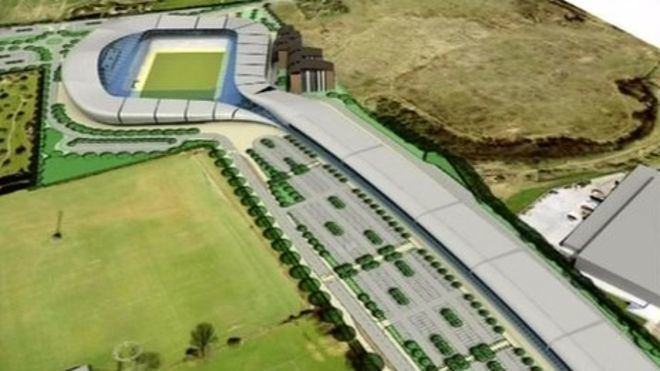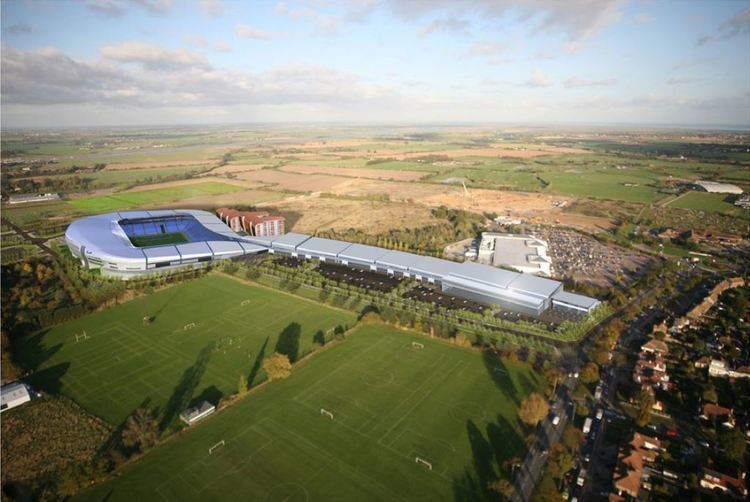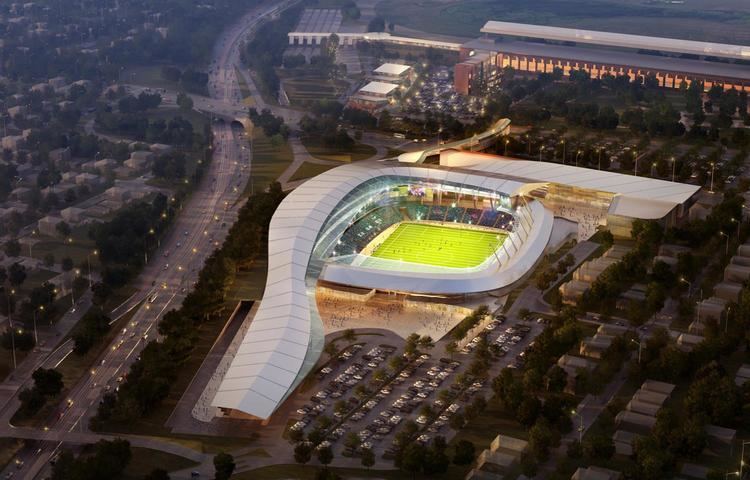Location Southend-on-Sea Capacity 22,000 | Operator Southend United Construction cost 80 million GBP | |
 | ||
Similar Roots Hall, York Community Stadium, UWE Stadium, New Queens Park, Five Towns Stadium | ||
Fossetts Farm Stadium is the provisional name for a stadium proposed to be built in Southend-on-Sea as a new home for Southend United F.C. to replace Roots Hall Stadium. The name may change if sponsorship for the stadium is secured. Planning permission was confirmed in 2008, but the scheme depends on financing from an adjacent retail development, and it is not known if or when this will become commercially viable.
Contents
- Initial plans
- Financial preparation
- Plans presented to council
- Fossetts Farm or Roots Hall site
- Final stadium plan
- References

Initial plans

On 7 May 2006, Southend United chairman Ron Martin revealed that the much-awaited multi-million pound stadium at Fossetts Farm is likely to go ahead after prolonged discussions over the ownership of the football club resulted in the property developer becoming the sole owner of the Shrimpers. He added that a detailed planning application for the 22,000 all-seater stadium would be submitted to the local authorities "in the next three or four months" with the aim to move into the new home for the start of the 2008/09 season.
Financial preparation

Billericay-based property development company Martin Dawn took control of Southend United in November 1998 with chairman and chief executive Ron Martin, claiming that his company "is committed to a successful football club on and off the field, both of which can be enhanced by the future possibility of a new stadium and improved facilities for all." In March 1999 Southend United's Roots Hall ground was sold for £4 million to Martin Dawn subsidiary Roots Hall Limited to clear a £3.87 million debt; the club would lease back the ground at an annual rent of £400,000. Chairman at the time John Main was quick to calm the nerves of worried fans: "There is no question of Roots Hall being bulldozed to the ground before we have relocated to a new stadium – this club will not be homeless." But disgruntled shareholders demanded the resignations of several members of the board at an EGM called to rubber-stamp the sale, claiming that they should stand down for allowing the club to slip so dangerously into the red and forcing the sale of the club's only real asset. "These board members should be made to resign after displaying their utter incompetence by allowing the company to trade in an insolvent situation," exclaimed one annoyed shareholder.
Plans presented to council

In September 1999 Southend United announced that plans for a new multi-million pound stadium would be presented to council chiefs within weeks with chairman John Main confident that the club would be given permission to start construction early in the new millennium. "The council have been very supportive and we hope that the planning application passes through successfully", said Main. "If it does we can look forward to moving into a new state-of-the-art home within the next few years."

Plans for the new 15,000 seater stadium on the Boots & Laces training ground location were put on hold in February 2000 after it was discovered that an ancient 14-acre (57,000 m2) Bronze Age burial ground entered onto the planned site. By March 2000 supporter frustration grew as the club continued to fail to meet promised planning application submission dates. The Southend United Supporters Club Trust (SUSCT) observed that the club was running out of time. "We're no nearer to getting a new home now than we were 12 months ago, which is very worrying because we are running out of time fast," said chairman Trevor Bashford. Members of Southend Council were equally eager to see some progress. In late May 2000 Council chief executive George Krawiec threw his weight behind the proposals but admitted that he would like to see some progress made on the planning front. "We await both eagerly and anxiously Southend United's planning application so we can look at it properly within the correct guidelines," said Krawiec.
Fossetts Farm or Roots Hall site

The plans which were submitted in July 2000 for a £12.5 million 16,000 seater stadium on the Fossets Farm site but the proposal fell through almost immediately after a rival property development company revealed that it actually owned much of the site. All the waiting and anticipation could have been for nothing when Southend United came to the brink to extinction after a £400,000 demand from the Inland Revenue went unpaid. Boardroom turmoil saw chairman John Main removed in return for principal benefactor Delancey Estates settling the debt.

In September 2001 it was claimed that Southend United would remain at Roots Hall after a deal was proposed between property developers Lansbury and Delancey, a joint major share-holder in the football club.

Speaking to shareholders at the club's AGM, Ron Martin said that the proposal for a 16,000 capacity ground should go before the planning committee on 7 February 2001 and that he was "confident" that both the football club and local council were on the same wavelength. The council decided to defer the decision for a further three months but agreed that a decision had to be made by then. "This application has been with us for some time and we must not as a council allow this application to cast a further shadow," said Councillor Roger Weaver (CON). "To prevent this hanging over the council anymore, can we ask that officers come back within three months time with a yea or nay recommendation." The fans set up an action group 'Save Our Southend' to prevent their club from becoming homeless or even extinct. "We want our football team's future to be protected in the borough of Southend," said SOS spokesman Trevor Bashford. Even former boss David Webb voiced his concerns for the club: "I'm still very sceptical about what will happen to the club if the stadium doesn't come off."
In June 2001 the club pulled out of the planning meeting which was scheduled to make a decision on the Fossetts Farm proposal, citing that it "needed more time to assess the content of its project". SEL UK, the club's joint owner, later declared that they wanted to sell the club: "The directors are currently seeking to sell the company's interest in Southend United" stated the auditors' report. Ron Martin moved to re-assure that the joint owners of Martin Dawn and Delancey were not about to cut and run: ""The position is quite clear – Martin Dawn and Delancey are only interested in the longevity of Southend United." In August former chairman John Main, ousted after a bitter boardroom struggle in 2000, warned fans that the proposal was not "financially viable" and that "there will be no stadium at Fossetts Farm and the future of the football club remains at Roots Hall."
Final stadium plan
On 3 August 2006 local media reported that work was to start in 2007 on a £25 million 22,000 superstadium on the site at Fossetts Farm. Martin stated that "plans are at an advanced stage now" and added that they would be submitted in late September 2006 after which there will be a 16-week public consultation. The new ground has been designed by Populous, formerly known as HOK Sport, the company which built Arsenal's new Emirates Stadium, Sydney's Telstra Stadium, which hosted the 2000 Olympics and the London 2012 Olympic stadium. Populous, have also been involved in the building of the new Wembley Stadium.
